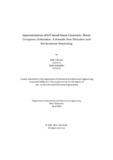| dc.contributor.advisor | Shabnam, Farzana | |
| dc.contributor.author | Hassan, Rakin | |
| dc.contributor.author | Salauddin, Sadia | |
| dc.date.accessioned | 2021-03-21T06:23:18Z | |
| dc.date.available | 2021-03-21T06:23:18Z | |
| dc.date.issued | 2020-04 | |
| dc.identifier.other | ID: 14321012 | |
| dc.identifier.other | ID: 15121037 | |
| dc.identifier.uri | http://hdl.handle.net/10361/14362 | |
| dc.description | This thesis is submitted in partial fulfillment of the requirements for the degree of Bachelor of Science in Electrical and Electronic Engineering, 2020. | en_US |
| dc.description | Cataloged from PDF version of thesis. | |
| dc.description | Includes bibliographical references (pages 42-43). | |
| dc.description.abstract | IoT or Internet of Things was a term coined by Kevin Ashton in 1999. It is used to describe a system where different physical and digital devices are connected together and can communicate via the internet. The main goal of our project is to use IR sensors to count the total number of students that are entering and exiting the classroom and thus calculating the total number of students that are present. Furthermore, we are using Radio-frequency identification (RFID) to create a card scanning system that will allow us to allocate seats for the students during exam time. We also installed temperature, humidity and flame sensors inside the classroom which will give data in real time and can be used for both emergency and any regular data collecting purposes. The micro controller we used to power all these systems was Arduino Uno. All the information collected by the Arduino will be uploaded to a server via NodeMCU or ESP8266 modules where a university administrator can access all the information in real time. Nowadays, most of the universities take attendance manually. This is a problem as manual attendance is not always fully effective. Calculating the total number of students using IR sensors will make it very easy for the lecturers to crosscheck with the attendance if need be. For one, student count can be a very important factor in emergency situations and the police and/or the fire department can need this information in such situations. Secondly, manually taking the attendance and crosschecking can be a tedious and time consuming task for the lecturers and this can save a lot of time. On top of that, students can give attendance for their friends who are not actually present in the class and getting this information can help reduce proxies. Also, the data collected can be used by the university or other people or organizations for R&D. In exam time, automatic seat allocation will help reduce hassle and save time. We plan to do all these in a very cost effective way | en_US |
| dc.description.statementofresponsibility | Rakin Hassan | |
| dc.description.statementofresponsibility | Sadia Salauddin | |
| dc.format.extent | 43 pages | |
| dc.language.iso | en_US | en_US |
| dc.publisher | Brac University | en_US |
| dc.rights | Brac University theses are protected by copyright. They may be viewed from this source for any purpose, but reproduction or distribution in any format is prohibited without written permission. | |
| dc.subject | IoT | en_US |
| dc.subject | Internet of Thing | en_US |
| dc.subject | Room Occupancy | en_US |
| dc.subject | Automatic Seat Allocation | en_US |
| dc.subject | Environment Monitoring | en_US |
| dc.subject | Arduino UNO | en_US |
| dc.subject | IR Sensor | en_US |
| dc.subject | RFID | en_US |
| dc.title | Implementation of IoT based smart classroom: Room occupancy estimation, automatic seat allocation and environment monitoring | en_US |
| dc.type | Thesis | en_US |
| dc.contributor.department | Department of Electrical and Electronic Engineering, Brac University | |
| dc.description.degree | B. Electrical and Electronic Engineering | |

